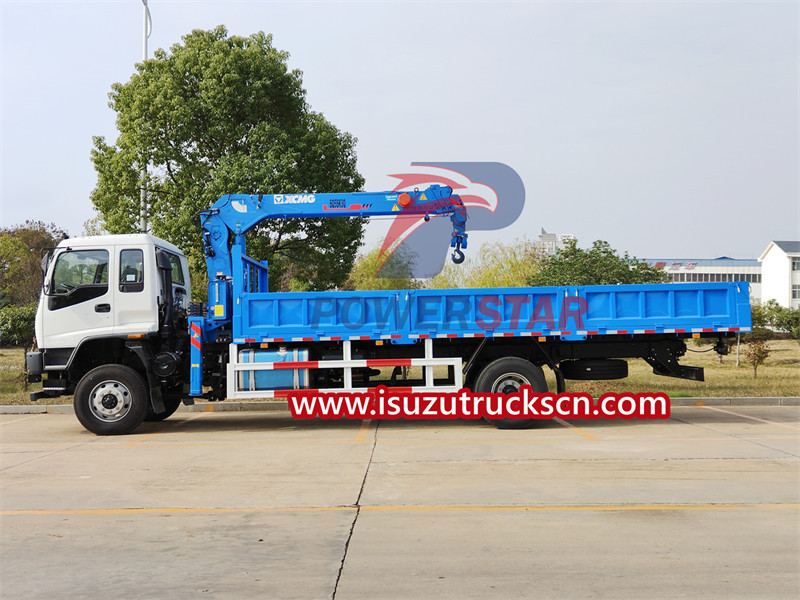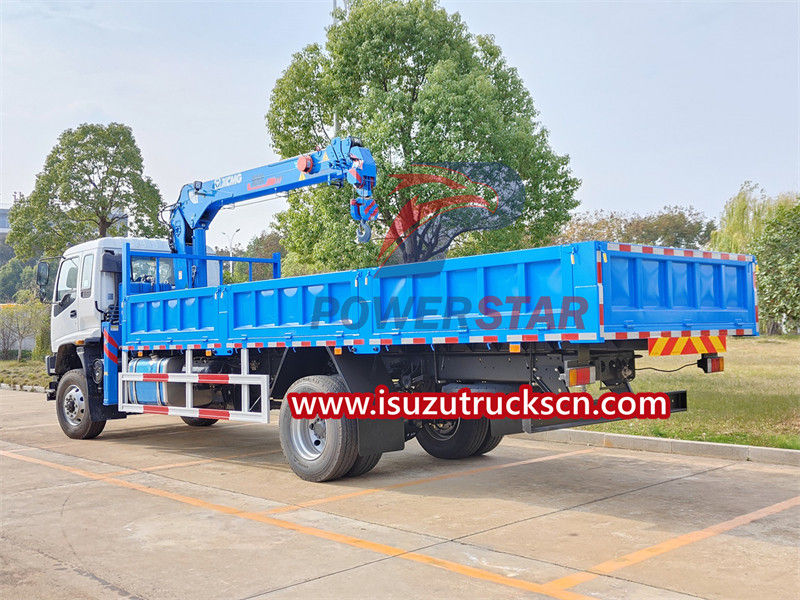ISUZU FVR truck-mounted crane is a high-strength, durable and stable special vehicle. Its core component, the crane, uses advanced materials and technology, with a maximum lifting capacity of up to 5 tons, meeting most engineering needs. The vehicle is based on the Isuzu FVR AWD chassis, which has good load-bearing capacity and stability, and is equipped with a reinforced suspension system to improve driving comfort and stability. ISUZU crane truck is equipped with a high-quality hydraulic system, which can withstand larger workloads, provide stable and smooth power output, reduce swing and shaking during hoisting, and improve operating accuracy and stability.
Work capacity:
5000 kgTruck model:
PT5050JSQEngine power:
240 HPEngine type:
6HK1-TCLAxle drive:
4×4Gear box:
MLD 6-speed manualRemarks:
ISUZU FVR 4×4 chassis, customized color
ISUZU truck-mounted crane, also called ISUZU boom crane truck, is a new type of efficient lifting and transportation equipment installed on a truck chassis that integrates lifting and transportation. Its working principle is to take power from the automobile gearbox to drive the hydraulic pump to rotate and provide high-pressure oil to each hydraulic working component, thereby realizing various movements of the truck-mounted crane. ISUZU truck-mounted cranes are recognized and accepted by more and more users for their advantages of speed, flexibility, efficiency, convenience, and integration of loading, unloading, and transportation. It has been widely used for cargo loading and unloading and short-distance transfer of goods in industries such as transportation, civil construction, communications, power, and urban pipeline network construction.
The ISUZU FVR 4×4 crane truck is modified on the ISUZU FVR all-wheel drive chassis and is equipped with a XCMG telescopic boom. The boom is a box-shaped structure with a five-sided cross-section, which has good rigidity and good anti-vibration performance during rotation control. The boom has a four-section telescopic structure and is made of high-strength steel plates. The maximum lifting capacity is 5t, the maximum luffing angle is 75°, and the maximum lifting height is 11.2m. A locking pin is installed to the slewing mechanism to control the swing of the boom during driving.
The ISUZU FVR truck-mounted crane is equipped with hydraulic outriggers, which adopt a quadrilateral box structure and are telescopic through hydraulic cylinders. The horizontal span of the outriggers reaches 5.1 m, which meets the stability requirements of the vehicle under various working conditions.
Product Specifications
|
ISUZU FVR 4×4 crane truck specifications |
|||
|
Overall dimensions |
8400×2500×3650(mm) |
Cargo box dimensions |
5000x2500x550(mm) |
|
Gross vehicle weight |
18,000 kg |
Rated Load capacity |
10,000 kg |
|
Chassis specifications |
|||
|
Chassis Brand |
ISUZU |
Color |
Blue |
|
Engine |
Fuel Type |
Diesel |
|
|
Horse power |
177kw/240HP |
||
|
Displacement |
7790 ml |
||
|
Engine Type |
6 cylinders in line, water cooling, intercooled, turbocharged |
||
|
Emission Standard |
Euro V |
||
|
Wheel Base |
5550 mm |
Driving type |
4x4 |
|
Type & Size of Tyre |
295/80R22.5 (6+1pcs) |
Air Conditional |
Heating and cooling air conditioning |
|
Cab |
Single-row, with sleeper |
Gear Box |
ISUZU MLD-6Q, 6 speed forward with 1 reverse, manual |
|
Brake |
Air brake |
Steering Wheel |
Left Hand Drive with power-assisted |
|
Crane specifications |
|||
|
Crane model |
SQ5SK3Q |
Crane weight |
2230 kg |
|
Max. lifting weight |
5000 kg |
Max. working height |
11.2 m |
|
Max oil flow of hydraulic system |
40 L/min |
Rated pressure of hydraulic system |
22 Mpa |
|
Oil tank capacity |
90 L |
Installation space |
900 mm |
|
Max. working radius |
11 m |
Max lifting Moment |
12.5 T.M |
|
Lifting capacity/working radius |
Lifting capacity(kg) |
working radius(m) |
|
|
5000 |
2.5 |
||
|
2800 |
3.62 |
||
|
1500 |
6.05 |
||
|
1100 |
8.60 |
||
|
400 |
11 |
||
|
Rotation angle |
360°, all rotation |
Boom |
4 sections |

What is the difference between Isuzu truck-mounted crane and mobile crane?
In the engineering construction and logistics transportation industries, Isuzu truck-mounted cranes and truck cranes are common lifting equipment, but there are big differences between them.
1. Hoisting method
The ISUZU truck-mounted crane fixes the boom on the ISUZU chassis. This design makes it impossible for the boom to telescope when the vehicle is traveling, thus limiting its lifting capacity. The mobile crane installs the boom on the chassis of the heavy duty chassis, allowing the length of the boom to be expanded and retracted as needed while driving. This design gives the mobile crane greater flexibility and can handle a variety of lifting needs.
2. Scope of application
ISUZU crane trucks are usually suitable for short-distance lifting operations, such as construction projects, warehouse cargo loading and unloading, etc. Mobile cranes are usually suitable for long-distance hoisting operations, such as road construction, bridge installation, etc.

3. Difficulty of operation
The operation of the ISUZU truck with crane is relatively simple because its lifting capacity is relatively small and only one operator is usually required to complete the job. Due to its larger hoisting capacity and more flexible operating characteristics, mobile cranes usually require two operators to work together, making the operation relatively difficult.
4. Maintenance costs
The structure of the ISUZU truck-mounted crane is relatively simple and the maintenance cost is relatively low. Due to its complex structure and higher technical content, the maintenance cost of mobile cranes is usually higher.
5. Structural features
ISUZU truck with cranes are compact and usually equipped with a shorter boom and a smaller winch. This design allows it to work well in a small space. The structure of the mobile crane is larger, usually equipped with a longer boom and a larger winch. This allows the truck crane to exert greater operating advantages in open spaces.
6. Hoisting capacity
Due to differences in structure and design, the lifting capacity of ISUZU truck-mounted cranes is usually smaller, generally between 3-16 tons. The lifting capacity of mobile cranes is larger, ranging from tens to hundreds of tons. This enables the mobile crane to cope with heavier loads and greater operational demands.